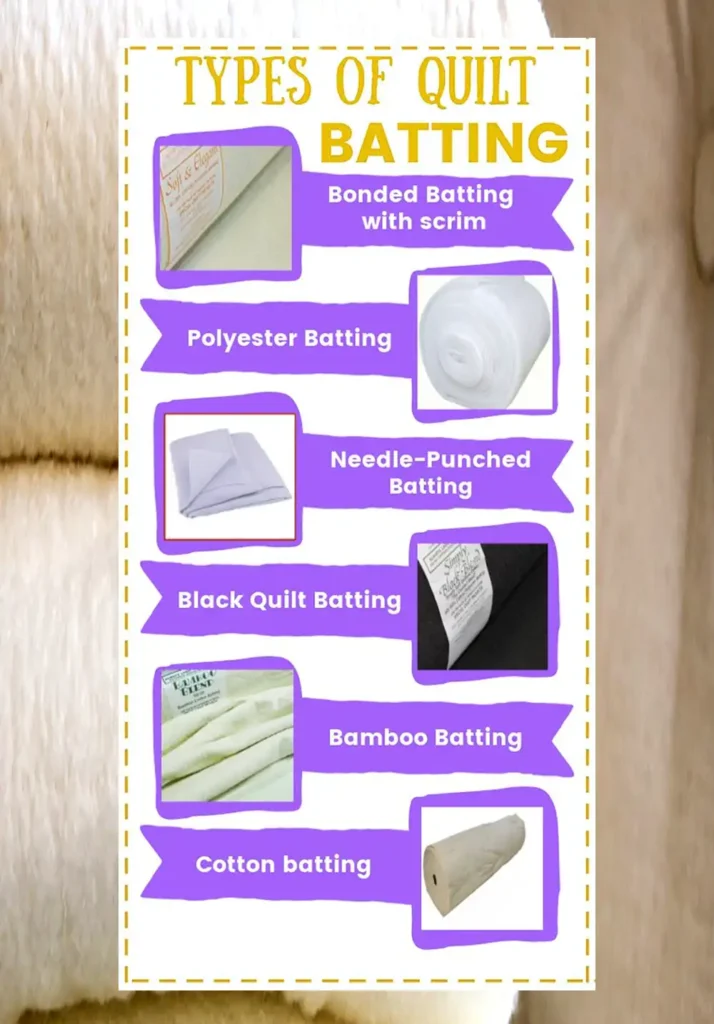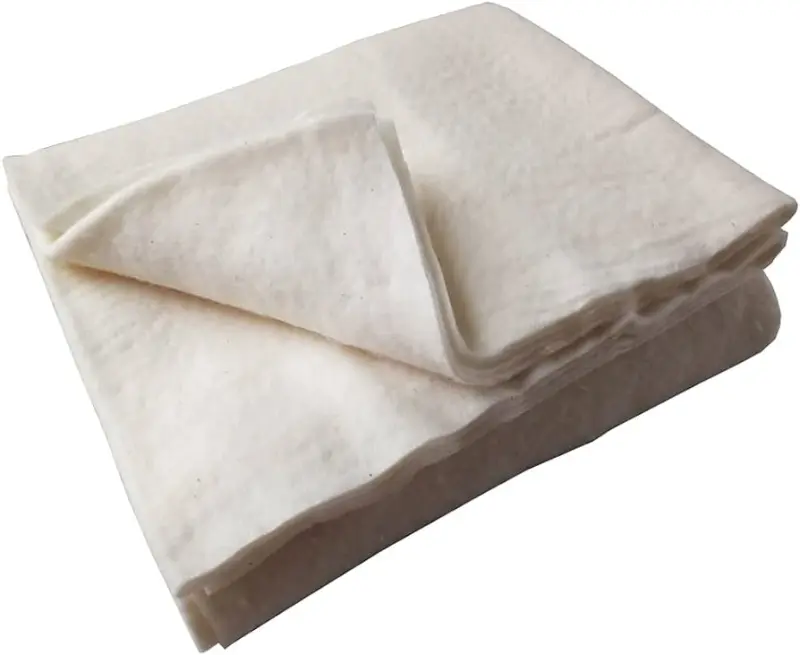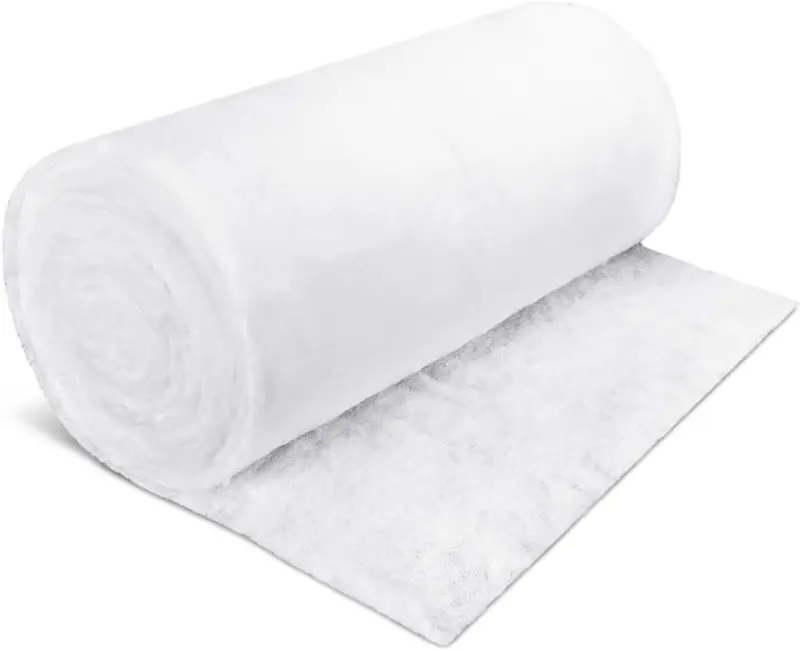When it comes to quilting, choosing the right type of batting is just as important as selecting the perfect fabric. The batting provides the structure, warmth, and overall feel of your quilt. But with so many options available, how do you know which type to choose? Each batting type offers different benefits depending on the quilt’s purpose, your quilting style, and the desired outcome.
Let’s explore the various types of quilt batting and their uses. From natural fibers like cotton to synthetic materials like polyester, there’s a batting option for every need.
Whether you’re making a lightweight summer quilt or a cozy winter throw, understanding the different types of quilt batting will help you select the one that works best for your project. Let’s dive into the world of batting and make sure you choose the right one for your next quilt!
What is Quilt Batting?
Quilt batting is an essential layer of material used in quilting to add warmth, softness, and structure to your quilt. Positioned between the quilt top and the backing fabric, batting is what gives quilts their cozy, padded feel.
Available in a variety of types—including cotton, polyester, bamboo, wool, and blends—quilt batting comes in different thicknesses or lofts, allowing quilters to choose the perfect batting for their needs. Whether you’re making a lightweight summer quilt or a warm winter blanket, the type of quilt batting you choose will affect the quilt’s drape, feel, and durability.
When quilting, the batting is typically stitched through all layers of the quilt to hold it in place, helping to maintain the quilt’s shape and longevity. The variety of quilt batting types available also offers different benefits, such as breathability, moisture-wicking, and temperature regulation. Choosing the right batting can make a big difference in the final look and feel of your quilt.
7 Types of Quilt Batting
When it comes to quilting, the batting you choose can make all the difference in the finished product. The right batting enhances the texture, warmth, and durability of your quilt. But with so many options available, how do you decide? Let’s explore seven popular types of quilt batting, their benefits, and how to choose the perfect one for your next project.
| Batting Type | Benefits | Ideal Uses | Care Tips |
|---|---|---|---|
| Cotton Quilt Batting | Soft, breathable, naturally hypoallergenic. Adds a crinkly, vintage look. | Best for lightweight quilts, bed quilts, year-round use. | Pre-wash to avoid shrinkage, gentle wash, avoid high heat. |
| Polyester Quilt Batting | Lightweight, durable, retains shape, eco-friendly. | Great for wall hangings, table runners, and durable quilts. | Machine washable and dryable, no special care needed. |
| Wool Quilt Batting | Warm, breathable, lightweight, excellent insulation. | Perfect for winter quilts, throws, and heavy comforters. | Dry clean or hand wash with wool-safe detergent. |
| Bamboo Quilt Batting | Eco-friendly, smooth, breathable, and naturally anti-bacterial. | Ideal for baby quilts or lightweight summer quilts. | Machine washable, retains softness after multiple washes. |
| Polyester/Cotton Blend Batting | Combines softness of cotton with durability of polyester. | Great for general projects, offering balance of comfort and structure. | Machine washable and dries quickly. |
| Silk Quilt Batting | Luxurious, lightweight, smooth, and high-end finish. | Perfect for high-end or heirloom quilts, luxurious projects. | Dry clean only, handle with care. |
| Recycled Quilt Batting | Eco-conscious, affordable, made from repurposed fibers. | Suitable for budget-conscious quilters or sustainable projects. | Machine washable, handle gently to maintain quality. |

1. Cotton Batting

Cotton batting is made from 100% natural cotton fibers. It’s widely used because of its soft, breathable qualities, making it perfect for warmer climates or lightweight quilts. This type of batting offers a cozy, soft feel without being too heavy, and it tends to have a bit of a “crinkly” texture after washing, adding a vintage, well-loved look to your quilts.
One of the best features of cotton batting is its breathability. It keeps you warm but doesn’t trap excess heat, making it ideal for bed quilts or projects that will be used year-round. Plus, it’s naturally hypoallergenic, so it’s great for those with sensitive skin.
However, cotton batting does require a little more care than synthetic options. If you want to avoid excessive shrinkage or crinkling, you can pre-wash it before quilting. Once the quilt is finished, wash it gently, and avoid using high heat in the dryer to maintain its softness and prevent distortion.
2. Polyester Quilt Batting

Polyester batting is made from synthetic fibers, often sourced from recycled materials, making it an eco-friendly option. It’s lightweight, durable, and holds its shape well. Polyester batting does not shrink, which is a significant advantage for quilters who want a low-maintenance option.
This batting type retains loft well, meaning it adds more volume to your quilts, making them feel fluffier and thicker without weighing them down. It’s ideal for projects that require more structure or durability, such as wall hangings or table runners. If you’re looking to make a quilt that can withstand heavy use or frequent washing, polyester batting is an excellent choice.
It’s also incredibly easy to care for. Polyester batting is machine washable and dryable, so you don’t have to worry much about special handling. Just toss it in the laundry and let the machine do the work.
3. Wool Quilt Batting
Wool batting is made from 100% natural wool fibers, and it’s known for its ability to keep quilts warm while still being lightweight. Wool offers excellent insulation, so it’s perfect for creating thick, cozy quilts that can handle the cold months. If you love the idea of a quilt that feels soft yet substantial, wool batting delivers just that.
One of the standout benefits of wool batting is its natural breathability. It keeps you warm without overheating, allowing air to circulate freely. This makes it ideal for comforters, throws, or any quilt you want to use during winter or colder seasons. It also has great loft, adding a little extra puff to your project.
However, wool batting requires more careful handling. Typically, it should be dry cleaned or hand-washed with a wool-safe detergent. You’ll want to avoid machine washing, as it can shrink or lose its loft. If you’re after a high-end, luxury feel, wool is a great choice, but keep in mind the additional care it needs.
4. Bamboo Quilt Batting
Bamboo batting is a natural fiber option made from bamboo pulp, often blended with cotton or polyester for added durability. This eco-friendly option offers softness, breathability, and a silky smooth texture. Bamboo is also naturally anti-bacterial, which makes it a great choice for baby quilts or any project you want to be extra gentle and healthy.
The biggest advantage of bamboo batting is its breathability. It’s perfect for warmer climates or summer quilts, as it allows air to flow freely and prevents overheating. Bamboo batting is also surprisingly soft and smooth, adding a luxurious feel to your quilt. It has a moderate loft, making it ideal for projects where you want a soft, drapey finish.
Bamboo batting is machine washable, and it retains its softness even after multiple washes. Just like cotton, you’ll want to wash it gently to keep it in good condition. It’s a great option for quilters looking for a more sustainable batting choice that doesn’t compromise on quality.
5. Polyester/Cotton Blend Batting
A polyester/cotton blend batting combines the softness of cotton with the durability of polyester. This batting is often chosen for its balance of comfort and structure. The cotton adds a nice, soft drape to your quilt, while the polyester helps it hold its shape and resist shrinkage, making it an excellent all-around option for quilting projects.
This blend offers great versatility. Whether you’re making a lightweight summer quilt or a more substantial bedspread, this batting will provide the right amount of warmth and loft. It’s also much easier to care for than pure cotton or wool, which makes it perfect for quilts that need regular washing or heavy use.
Polyester/cotton blend batting is machine washable and dries quickly, retaining its loft even after multiple washes. If you want a hassle-free, durable batting that still feels soft, this blend is a solid choice.
6. Silk Quilt Batting
Silk batting is made from luxurious silk fibers, offering a lightweight, smooth, and high-end finish to your quilts. This type of batting is perfect for those who want to add an extra touch of luxury and sophistication to their projects. It has a fine texture that feels incredibly soft and smooth against the skin.
Silk is known for its lightweight nature, which gives your quilt a delicate, airy feel while still providing warmth. It’s perfect for high-end quilts, heirloom projects, or anything where you want to make a statement with a soft, luxurious fabric. Silk batting also provides a beautiful drape, which makes it ideal for quilts that will be displayed or showcased.
However, silk requires special care. It should be dry cleaned to maintain its soft texture and integrity. It’s a bit more fragile than other types of batting, so you’ll need to be cautious with cleaning and storage. If you’re working on a high-end project and want a soft, elegant finish, silk batting is the way to go.
7. Recycled Quilt Batting
Recycled quilt batting is made from repurposed materials like polyester or cotton, making it an eco-conscious and affordable option for quilters. If sustainability is important to you, this is a great choice. Recycled batting offers many of the same benefits as standard polyester or cotton batting, but with the added bonus of reducing waste.
This type of batting is great for budget-conscious quilters, as it often costs less than other options. While it may not have the luxurious feel of silk or wool, it still provides the warmth and loft needed for a functional quilt. Recycled batting can be used in a variety of projects, from bed quilts to smaller items like placemats and table runners.
Recycled batting is machine washable and easy to care for, but be mindful of handling it gently. Since it’s made from repurposed fibers, it may require a bit more care to ensure it stays in good shape over time.
How To Choose Batting For A Quilt?

When deciding which batting to use for your quilt, it’s important to think about your quilt’s purpose and the type of project you are working on. The batting you choose will affect the warmth, texture, and ease of quilting.
1. Consider How You’ll Use the Quilt
Start by asking yourself how you intend to use the quilt. Do you want it to be warm and cozy or more decorative? For warmer quilts, opt for thicker batting to provide insulation. For decorative quilts, thinner batting works best, as it adds less bulk.
2. Evaluate the Loft of the Batting
Loft refers to the thickness and fullness of the batting. A higher loft will provide more insulation, which is great for colder climates. However, higher loft also makes quilting more challenging. Choose a loft that offers warmth but remains manageable for quilting. If you’re a beginner, a medium or low loft will be easier to work with.
3. Understand Fiber Content
The type of fiber in your batting affects its qualities. Polyester is durable and budget-friendly, making it ideal for everyday quilts. Wool is breathable and naturally warm, perfect for colder climates or comforters. Recycled batting is an eco-friendly option, but it may have a different texture or feel. Consider what’s most important for your project — durability, warmth, sustainability, or softness.
4. Ease of Quilting
Not all batts are the same when it comes to quilting. Some materials are easier to quilt through than others. Polyester batting is usually smooth, making it easier to stitch through. On the other hand, wool batting can be more challenging, especially for beginners. If you’re new to quilting, opt for a batting that’s easier to handle to avoid frustration.
5. Consider the Care Instructions
Different batting materials come with different care instructions. Some batts can be machine-washed and dried, while others may require hand washing or special care. Be sure to choose a batting that matches your preferred care routine and how often you plan to wash the quilt.
6. Allergies and Sensitivities
If you or the person receiving the quilt has allergies, be mindful of the fiber content. Hypoallergenic batting options are available, and synthetic fibers like polyester are often a safer choice. Wool can be a great option too, but be cautious with recycled batting, as it may contain allergens depending on its source.
Conclusion
Choosing the right quilt batting is essential for achieving the perfect balance of warmth, loft, and durability in your quilt. Every type of batting, from breathable cotton to luxurious silk, offers unique qualities that can enhance your project.
Consider factors like the climate, care requirements, and desired texture to find the ideal batting for your specific needs. Take your time to experiment with different options, and don’t be afraid to try something new!
For your next quilt project, choose high-quality bulk quilt batting from Fanda Fabric. We offer a wide range of batting options, ensuring you find exactly what you need for your next masterpiece.
Types Of Quilt Batting FAQ
How To Assemble Quilt Top Batting And Backing?
Assembling the quilt top, batting, and backing together is a crucial step to make your quilt sandwich. Follow these steps for the best results:
Prepare Your Work Area: Lay your backing fabric on a flat surface, smoothing out any wrinkles.
Center the Batting: Place your batting over the backing fabric. Make sure it is centered and covers the backing entirely.
Add the Quilt Top: Position the quilt top over the batting, aligning all edges.
Secure the Layers: Use pins, basting spray, or a basting stitch to secure the layers together. Ensure there is no shifting.
Trim the Excess: Once everything is aligned, trim any excess batting and backing, leaving about 1 to 2 inches around the edges.
How to Wash a Quilt with Cotton Batting?
Washing a quilt with cotton batting is simple but requires a bit of care to keep it looking great. Here’s a step-by-step guide:
Check the Quilt: Before washing, ensure the quilt is fully finished and that the batting is securely held in place.
Pre-wash (Optional): If you haven’t pre-washed your fabric, it’s best to do so now to prevent shrinkage.
Wash the Quilt: Use a mild detergent and wash the quilt on a gentle cycle in cold water. Cotton batting may shrink slightly, so avoid hot water.
Dry the Quilt: For best results, air dry your quilt by laying it flat. If you must use a dryer, tumble dry on low heat. Do not over-dry to avoid damaging the cotton batting.
Check for Shrinkage: Expect some shrinkage, which will give your quilt a crinkly texture, adding to its charm.
Quilt Batting Sizes
Quilt batting comes in various sizes depending on the quilt you are making. Here are the common sizes:
Crib: Typically 45″ x 60″ – Great for baby quilts.
Twin: Usually 72″ x 90″ – Ideal for single-bed quilts.
Full/Double: Around 81″ x 96″ – Suitable for full-size beds.
Queen: Measures approximately 90″ x 108″ – Fits a queen-size bed.
King: Generally 120″ x 120″ – Used for king-size beds.
When choosing a batting size, it’s important to pick one that’s slightly larger than your quilt top to allow for trimming after assembling the layers. This ensures your quilt will have enough batting to give it loft and warmth.
How to Put Batting in a Quilt?
Putting batting in a quilt is simple but important for keeping your quilt’s layers together. Follow these steps to do it properly:
Lay the Backing: Start by laying the backing fabric flat on your work surface.
Place the Batting: Spread the batting evenly over the backing fabric, smoothing out any wrinkles or creases.
Add the Quilt Top: Place the quilt top on top of the batting. Make sure all edges line up.
Baste or Pin: Use pins, basting spray, or hand basting to hold all three layers together. Focus on keeping the fabric taut and smooth.
Trim the Excess: If there’s any extra batting, trim it to match the size of your quilt top and backing.
Can I use blended batting in my quilt?
Yes, blended battings, such as cotton-polyester blends, combine the benefits of both fibers. They offer the softness of cotton with the durability and ease of care of polyester, making them a versatile choice.
What should I consider when choosing batting for a quilt?
Consider the quilt’s intended use, desired warmth, weight, and drape. Also, think about the type of fabric you’ll use and your personal preferences for softness and ease of care.
How does batting thickness affect my quilt?
Thicker batting adds more loft and warmth to the quilt, while thinner batting provides a flatter, more flexible finish. The thickness you choose should align with the quilt’s purpose and your comfort needs.
Can I use the same batting for all types of quilts?
Not necessarily. The best batting choice depends on the quilt’s purpose. For instance, a bed quilt might benefit from warmer, loftier batting, while a wall hanging could use thinner, more flexible batting.
How do I care for quilts with different types of batting?
Care instructions vary by batting type. Cotton and wool battings often require gentle washing, while polyester and blended battings are generally more durable and can handle more rigorous cleaning. Always follow the manufacturer’s care guidelines for the best results.
What is quilt batting and why is it important?
Quilt batting is the middle layer of a quilt, providing warmth, loft, and structure. It plays a crucial role in the overall feel and functionality of the quilt, affecting its drape, weight, and warmth.
